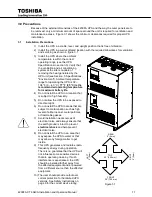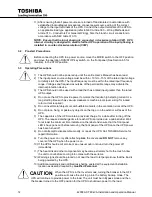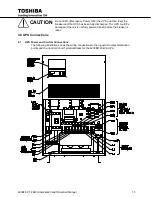
10
4200FA XT 80kVA Installation and Operation Manual
2.2
UPS Equipment Inspection
UPS Equipment Inspection
Upon receipt of the UPS, a careful inspection for shipping damage should be made. Use
caution when removing unit from pallet. Refer to labels or documentation attached to packing
material.
After Unpacking
1) Check the unit for loose, broken, bent or other damaged parts. If damage has occurred
during shipment, keep all packing materials for return to the shipping agent. The
equipment warranty will not apply to units that are damaged during shipment.
2) Check to see that the rated capacity and the model number specified on the nameplate
conform to the order specifications.
2.3
Storage of the UPS Equipment
If the UPS equipment is to be subject to long or short-term storage, the following guidelines
should be used.
Avoid:
1) Storage in sites subject to extreme changes in temperature or high humidity.
2) Storage in sites subject to exposure of high levels of dust or metal particles.
3) Storage on inclined floor surfaces or in sites subject to excessive vibration.
Before Storing:
1) Allow the UPS to be operated for 24 hours to ensure that the batteries are fully charged.
2) Stop the unit (see Shutdown Procedure in section 6.12).
3) Place the MCCB switch of the UPS in the OFF position (see section 4.1 for location).
Storing:
1) Store within the temperature range of -4 – 104 °F (-20 – 40 °C).
2) For best results, store the UPS in the original shipping container and place on a wood or
metal pallet.
3) The optimum storage temperature is 70 °F (21 °C). Higher ambient temperatures cause
UPS batteries to require recharging more frequently.
After Storing:
1) If stored in an ambient temperature less than 68 °F (20 °C); recharge the batteries every
9 months.
2) If stored in an ambient temperature of 68 – 86 °F (20 – 30 °C); recharge the batteries
every 6 months.
3) If stored in an ambient temperature of 86 – 104 °F (30 – 40 °C); recharge the batteries
every 3 months.
2.4
Disposal
Please contact your state environmental agency for details on proper disposal of electrical
components and packaging in your particular area.
ATTENTION
It is illegal to dump lead-acid batteries in landfills or dispose
of improperly.
Please help our Earth by contacting the
environmental protection agencies in your area, the battery
manufacturer, or call TOSHIBA toll-free at (800) 231-1412 for more
information about recycling batteries.
















































